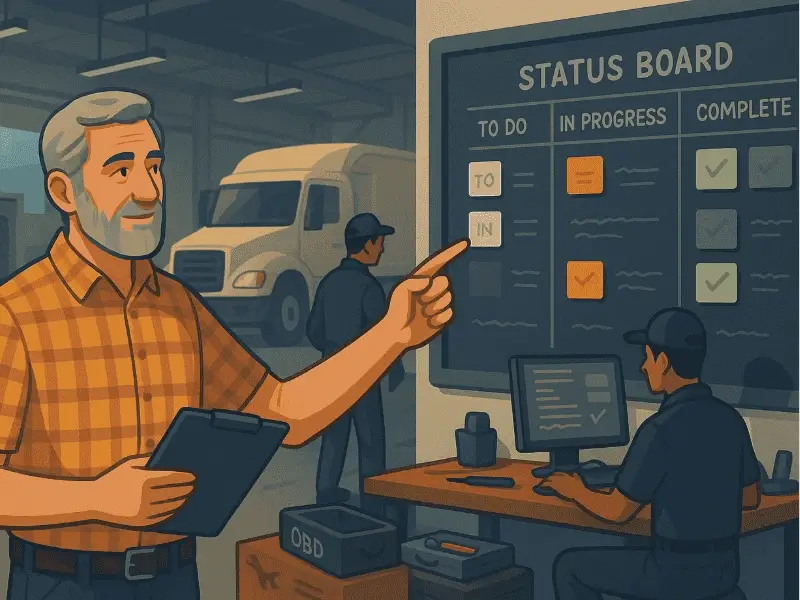Key Takeaways
Fleet management can be a challenging task, especially when dealing with a large number of vehicles. Many businesses rely on a diverse fleet of vehicles to deliver goods, provide services, or simply keep their operations running smoothly.
However, managing a fleet efficiently can quickly become chaotic, with paperwork piling up, maintenance issues going unnoticed, and costs spiraling out of control. To tackle these challenges, centralizing fleet management processes has become a crucial step towards success.
In this comprehensive guide, we will explore the benefits of centralizing fleet management, address the common paperwork challenges, discuss missed maintenance issues, and highlight the overall impact on reducing costs.
The Benefits of Centralizing Fleet Management
Centralizing fleet management means consolidating all aspects of managing your fleet into one streamlined system.
This system typically involves using fleet management software that provides a centralized dashboard for tracking vehicles, monitoring maintenance schedules, and managing paperwork.
Here are some key benefits of centralizing fleet management:
Improved Efficiency
With all data and tasks in one place, you can easily track vehicle locations, driver activities, and maintenance schedules. This streamlined approach reduces administrative work and helps managers make informed decisions quickly.
Enhanced Visibility
Centralization provides real-time visibility into your fleet's operations. You can monitor vehicle performance, fuel consumption, and driver behavior. It allows you to identify and address issues promptly.
Reduced Administrative Burden
Gone are the days of dealing with stacks of paperwork. Centralized systems automate administrative tasks, such as tracking expenses, managing work orders, and filing compliance reports.
Better Compliance Management
Meeting regulatory requirements and safety standards becomes more manageable with centralized data. Fleet managers can generate reports and maintain records easily, ensuring compliance with industry regulations.
Proactive Maintenance
Centralized fleet systems can automatically schedule and track maintenance tasks, reducing the risk of missed services and costly breakdowns. When integrated with a fleet management platform, Predictive maintenance algorithms can even help predict when a vehicle is likely to require repairs.
Download Our Free Fleet Maintenance Resources Now!
Common Paperwork Challenges in Fleet Management
Paperwork is an inherent part of fleet management, but it can quickly become a significant challenge when not properly managed. Centralizing fleet management processes can address these paperwork challenges effectively:
- Document Management: With a centralized system, all essential documents, such as driver licenses, vehicle registrations, and insurance certificates, can be digitized and stored securely. This eliminates the risk of losing critical paperwork and simplifies auditing processes.
- Fuel Receipts and Expense Reports: Tracking fuel receipts and managing expense reports manually can be time-consuming. Centralized systems can automate these processes, allowing drivers to submit expenses and receipts digitally, streamlining reimbursement and reducing the chances of errors.
- Compliance Reporting: Meeting compliance requirements often involves generating reports, maintaining records, and ensuring documentation accuracy. Centralized fleet management systems can generate accurate reports on demand, simplifying compliance management.
- Work Orders and Service Records: Keeping track of work orders, maintenance schedules, and service records is crucial for vehicle upkeep. A centralized system can automate these processes, ensuring that every service is logged, and records are easily accessible.
- Accident Reporting: When accidents occur, proper reporting and documentation are essential for insurance claims and legal purposes. A centralized system can guide drivers through the reporting process, ensuring all necessary information is captured.
Addressing Missed Maintenance Issues in Fleet Management
One of the significant challenges in fleet management is the risk of missed maintenance issues. These issues can result in unexpected breakdowns, costly repairs, and even accidents. Centralizing fleet management can help prevent these problems:
- Scheduled Maintenance: Centralized systems can automatically schedule routine maintenance based on vehicle usage, mileage, or engine hours. This proactive approach ensures that vehicles receive the necessary care at the right time, reducing the risk of breakdowns.
- Maintenance Alerts: Fleet management software can send alerts and notifications when vehicles are due for service or inspections. This real-time information allows fleet managers to plan maintenance activities efficiently.
- Preventive Maintenance Programs: Many centralized systems offer preventive maintenance programs that include checklists and detailed instructions for technicians. This ensures that maintenance tasks are carried out correctly and thoroughly.
- Predictive Maintenance: Some advanced fleet management solutions use predictive maintenance algorithms that analyze vehicle data to predict potential issues. By identifying problems before they become critical, predictive maintenance can save both time and money.
- Historical Maintenance Records: Centralized systems maintain historical maintenance records for each vehicle in the fleet. This data can help identify trends and patterns, allowing for more informed decisions about when to replace or retire vehicles.
Reducing Costs Through Centralized Fleet Management
One of the most significant benefits of centralizing fleet management is the potential for cost reduction. Here are several ways centralization can help lower costs:
Fuel Efficiency
Fleet management tools with centralized systems can monitor and analyze fuel consumption data, allowing managers to identify inefficiencies and optimize routes. This can result in significant fuel savings over time.
Reduced Downtime
With proactive maintenance and real-time monitoring, the risk of unexpected breakdowns is minimized. This reduces downtime, which can be costly in terms of lost productivity and emergency repair expenses.
Improved Driver Behavior
Centralized systems often include driver monitoring and scoring features. By promoting safe and efficient driving habits, these systems can lead to reduced fuel consumption, lower maintenance costs, and fewer accidents.
Route Optimization
Fleet management software can suggest optimal routes based on real-time traffic and weather data. This not only saves fuel but also reduces vehicle wear and tear.
Right-Sizing the Fleet
Historical data provided by centralized systems can help fleet managers determine if they have the right number and types of vehicles in their fleet. Reducing the size of the fleet when unnecessary can lead to substantial cost savings.
Final Words
Centralizing fleet management processes is a crucial step towards achieving control and success in managing your fleet. By addressing paperwork challenges, preventing missed maintenance issues, and reducing costs, centralized fleet management systems can significantly benefit your business.
The efficiency, visibility, and cost-saving potential offered by these systems make them an essential tool for modern fleet managers. Embracing centralized fleet management is not only a smart move but also a necessary one in today's competitive business landscape.



.png)








.png)


.png)




.webp)


